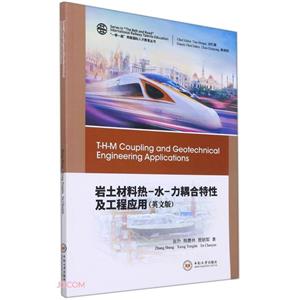-
>
湖南省志(1978-2002)?铁路志
-
>
公路车宝典(ZINN的公路车维修与保养秘籍)
-
>
晶体管电路设计(下)
-
>
基于个性化设计策略的智能交通系统关键技术
-
>
德国克虏伯与晚清火:贸易与仿制模式下的技术转移
-
>
花样百出:贵州少数民族图案填色
-
>
识木:全球220种木材图鉴
岩土材料热-水-力耦合特性及工程应用(英文版) 版权信息
- ISBN:9787548746676
- 条形码:9787548746676 ; 978-7-5487-4667-6
- 装帧:一般胶版纸
- 册数:暂无
- 重量:暂无
- 所属分类:>
岩土材料热-水-力耦合特性及工程应用(英文版) 内容简介
开展热-水-力耦合条件下的岩土材料力学特性研究,对于高放废弃物地质处置、地热资源开采、川藏铁路等重大工程建设都具有重要的理论意义和应用价值。本书聚焦工程建设中遇到的热-水-力耦合条件下的岩土工程问题,开展实验、理论和数值研究,详细阐述了岩土工程材料在热-力、水-力和热-水-力耦合条件下的力学特性及本构关系。具体研究内容如下:(1)研发了热-水-力耦合试验平台,开展了热-水-力耦合条件下的岩土材料力学特性测试研究。分析了耦合条件下岩土材料强度、变形、破坏模式的演化规律;(2)开展了岩土材料热-粘弹塑性本构模型研究。提出了一种称为等效应力的概念,基于等效应力的概念,在压缩和溶胀过程中,可以简单地通过e-lnp关系来评估温度变化与热力学塑性应变之间的关系。通过将时间效应添加到新提出的热弹塑性模型的子加载表面所采用的演化方程中,建立了一个新的随时间变化的总空隙率差异的演化方程。(3)基于Cam-clay模型,建立了非饱和条件下的土体热-弹塑性模型。该模型不仅可以描述一维固结试验,还可以通过一组参数更好地反映三维压缩剪切试验中温度对非饱和土变形和强度的影响。(4)提出了基于细观力学的饱和硬岩弹塑性损伤模型。在该模型中,通过热力学框架对饱和介质进行热-力耦合。提出了新的塑性和破坏准则来描述内部变量的演变。饱和硬岩力学响应的所有主要特征都可以通过该模拟得到很好的再现,例如破坏强度,体积应变的压实-膨胀转变和峰后区域的软化现象。与唯象学模型相比,本文提出的细观力学模型具有参数少,物理意义明确的优点。(5)详细推导了热-水-力-气耦合有限元方法的理论。在场方程中,过大的孔隙水压力,过大的孔隙空气压力,固相位移和温度被用作未知变量。在THMA FE-FD方案中,有限元用于均衡和能量守恒方程的空间离散化。该方案中的能量守恒并没有完全结合力学性能,因为本构模型描述的塑性变形引起的能量耗散虽然未必包括在上述守恒方程中,但它可能很小。与核废料产生的热能相比,在工程意义上可以忽略不计。(6)开展了实际工程的在热-水-力耦合的稳定性及安全性研究,探讨了在热-水-力耦合条件下工程的影响因素。
岩土材料热-水-力耦合特性及工程应用(英文版) 目录
1.1 Research background
1.2 Review of previous work
1.3 Features of this book
Chapter 2 Experimental Investigation on T-H-M Properties of Geotechnical Materials
2.1 Introduction
2.2 Experimental investigation on T-M properties of geotechnical materials
2.3 Experimental investigation on H-M properties of geotechnical materials
2.4 Summary
Chapter 3 Thermo-Elasto-Viscoplastic Model for Geotechnical Materials
3.1 Introduction
3.2 Concept of equivalent stress
3.3 Concept of extended subloading yield surface and a new therrno-elastoplastic model for soft sedimentary rock
3.4 A new simple thermo-elasto-viscoplastic model for soft sedimentary rock
3.5 Thermodynamic properties of thermo-elasto-viscoplastic model
3.6 Performance of newly proposed models
3.7 Summary
Chapter 4 Thermo-Eiastoplastic Constitutive Model for Saturated/Unsaturated Geotechnical Materials
4.1 Introduction
4.2 Derivation of thermo-elastoplastic constitutive model for saturated/unsaturated soil
4.3 Moisture characteristic curve considering the hydraulic hysteresis, the influence of void ratio and temperature
4.4 Performance of the MCC model
4.5 Performance of the constitutive model
4.6 Summary
Chapter 5 Hydraulic;Mechanical Damage Model for Geotechnical Materials
5.1 Introduction
5.2 Homogenization theory of composite materials
5.3 Poromechanical framework
5.4 Formulation of a micromechanical based elastoplastic damage model
5.5 Estimation of damage induced permeability
5.6 Performance of proposed models
5.7 Summary
Chapter 6 Thermo-Hydraulic-MechanicaI-Air Coupled Model for Geotechnical Materials
6.1 Introduction
6.2 Thermo-Hydraulic-Mechanical-Air coupling finite deformation algorithm of field equations
6.3 Summary
Chapter 7 Numerical Applications of T-H-M Coupling Problems
7.1 Introduction
7.2 Numerical simulations of frictional deep geological disposal for high-level radioactive waste
7.3 Numerical simulation of model test on slop failure in unsaturated shirasu ground
7.4 Numerical simulation of heating experiment
7.5 Numerical simulation of underground water-sealed cavern
7.6 Summary
References
- >
有舍有得是人生
有舍有得是人生
¥17.1¥45.0 - >
史学评论
史学评论
¥13.4¥42.0 - >
山海经
山海经
¥17.7¥68.0 - >
我从未如此眷恋人间
我从未如此眷恋人间
¥15.9¥49.8 - >
人文阅读与收藏·良友文学丛书:一天的工作
人文阅读与收藏·良友文学丛书:一天的工作
¥14.7¥45.8 - >
新文学天穹两巨星--鲁迅与胡适/红烛学术丛书(红烛学术丛书)
新文学天穹两巨星--鲁迅与胡适/红烛学术丛书(红烛学术丛书)
¥9.9¥23.0 - >
随园食单
随园食单
¥21.6¥48.0 - >
中国人在乌苏里边疆区:历史与人类学概述
中国人在乌苏里边疆区:历史与人类学概述
¥20.6¥48.0
-
黑科技驱动世界的100项技术
¥21.9¥69.8 -
黑科技:驱动世界的100项技术(八品)
¥21.9¥69.8 -
指火控弹道与射击诸元理论
¥38.7¥49 -
智能照明工程手册
¥29.9¥49.8 -
光电直读光谱分析技术与应用
¥38.7¥49 -
服务型制造
¥76.3¥109





















